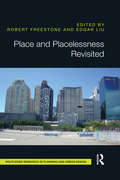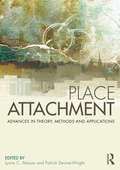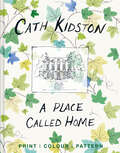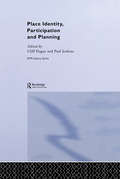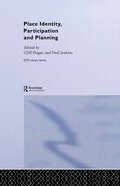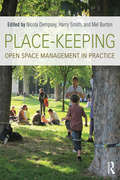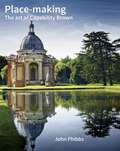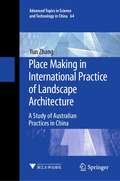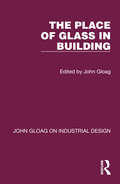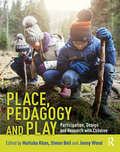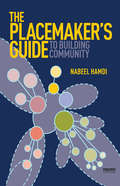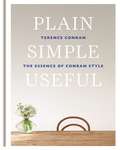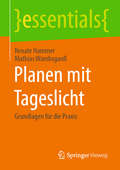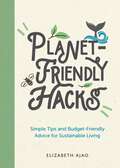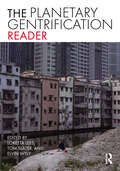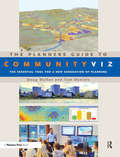- Table View
- List View
Place and Placelessness Revisited
by Robert Freestone Edgar LiuSince its publication in 1976, Ted Relph’s Place and Placelessness has been an influential text in thinking about cities and city life across disciplines, including human geography, sociology, architecture, planning, and urban design. For four decades, ideas put forward by this seminal work have continued to spark debates, from the concept of placelessness itself through how it plays out in our societies to how city designers might respond to its challenge in practice. Drawing on evidence from Australian, British, Japanese, and North and South American urban settings, Place and Placelessness Revisited is a collection of cutting edge empirical research and theoretical discussions of contemporary applications and interpretations of place and placelessness. It takes a multi-disciplinary approach, including contributions from across the breadth of disciplines in the built environment – architecture, environmental psychology, geography, landscape architecture, planning, sociology, and urban design – in critically re-visiting placelessness in theory and its relevance for twenty-first century contexts.
Place and Placelessness Revisited
by Robert Freestone Edgar LiuSince its publication in 1976, Ted Relph’s Place and Placelessness has been an influential text in thinking about cities and city life across disciplines, including human geography, sociology, architecture, planning, and urban design. For four decades, ideas put forward by this seminal work have continued to spark debates, from the concept of placelessness itself through how it plays out in our societies to how city designers might respond to its challenge in practice. Drawing on evidence from Australian, British, Japanese, and North and South American urban settings, Place and Placelessness Revisited is a collection of cutting edge empirical research and theoretical discussions of contemporary applications and interpretations of place and placelessness. It takes a multi-disciplinary approach, including contributions from across the breadth of disciplines in the built environment – architecture, environmental psychology, geography, landscape architecture, planning, sociology, and urban design – in critically re-visiting placelessness in theory and its relevance for twenty-first century contexts.
Place Attachment: Advances in Theory, Methods and Applications
by Lynne C. Manzo Patrick Devine-WrightRecipient of the 2014 EDRA Achievement Award. Place attachments are emotional bonds that form between people and their physical surroundings. These connections are a powerful aspect of human life that inform our sense of identity, create meaning in our lives, facilitate community and influence action. Place attachments have bearing on such diverse issues as rootedness and belonging, placemaking and displacement, mobility and migration, intergroup conflict, civic engagement, social housing and urban redevelopment, natural resource management and global climate change. In this multidisciplinary book, Manzo and Devine-Wright draw together the latest thinking by leading scholars from around the globe, capturing important advancements in three areas: theory, methods and application. In a wide range of conceptual and applied ways, the authors critically review and challenge contemporary knowledge, identify significant advances and point to areas for future research. This volume offers the most current understandings about place attachment, a critical concept for the environmental social sciences and placemaking professions.
Place Attachment: Advances in Theory, Methods and Applications
by Lynne C. Manzo Patrick Devine-WrightRecipient of the 2014 EDRA Achievement Award. Place attachments are emotional bonds that form between people and their physical surroundings. These connections are a powerful aspect of human life that inform our sense of identity, create meaning in our lives, facilitate community and influence action. Place attachments have bearing on such diverse issues as rootedness and belonging, placemaking and displacement, mobility and migration, intergroup conflict, civic engagement, social housing and urban redevelopment, natural resource management and global climate change. In this multidisciplinary book, Manzo and Devine-Wright draw together the latest thinking by leading scholars from around the globe, capturing important advancements in three areas: theory, methods and application. In a wide range of conceptual and applied ways, the authors critically review and challenge contemporary knowledge, identify significant advances and point to areas for future research. This volume offers the most current understandings about place attachment, a critical concept for the environmental social sciences and placemaking professions.
A Place Called Home: Print, Colour, Pattern
by Cath KidstonCath Kidston – queen of vintage-inspired homeware and joyously decorated spaces – grants unprecedented insight into her creative process and personal style in this lifestyle-meets-memoir-meets-interior-design book.
Place Identity, Participation and Planning (RTPI Library Series)
by Cliff Hague Paul JenkinsThe central concern of this book is place identity, and its representation and manipulation through planning. Place identity is of growing international concern, both in planning practice and in academic work. The issue is important to practitioners because of the impact of globalisation on notions of place. This book includes comparisons between Norway, the Netherlands, Sweden and Scotland, focusing strongly on the question of how different spatial planning systems and practices are currently conceiving and affecting issues of place identity.
Place Identity, Participation and Planning (RTPI Library Series #Vol. 7)
by Cliff Hague Paul JenkinsThe central concern of this book is place identity, and its representation and manipulation through planning. Place identity is of growing international concern, both in planning practice and in academic work. The issue is important to practitioners because of the impact of globalisation on notions of place. This book includes comparisons between Norway, the Netherlands, Sweden and Scotland, focusing strongly on the question of how different spatial planning systems and practices are currently conceiving and affecting issues of place identity.
Place-Keeping: Open Space Management in Practice
by Nicola Dempsey Harry Smith Mel BurtonPlace-Keeping presents the latest research and practice on place-keeping – that is, the long-term management of public and private open spaces – from around Europe and the rest of the world. There has long been a focus in urban landscape planning and urban design on the creation of high-quality public spaces, or place-making. This is supported by a growing body of research which shows how high-quality public spaces are economically and socially beneficial for local communities and contribute positively to residents’ quality of life and wellbeing. However, while large amounts of capital are spent on the creation of open spaces, little thought is given to, and insufficient resources made available for, the long-term maintenance and management of public spaces, or place-keeping. Without place-keeping, public spaces can fall into a downward spiral of disrepair where anti-social behaviour can emerge and residents may feel unsafe and choose to use other spaces. The economic and social costs of restoring such spaces can therefore be considerable where place-keeping does not occur. Place-Keeping also provides an accessible presentation of the outputs of a major European Union-funded project MP4: Making Places Profitable, Public and Private Open Spaces which further extends the knowledge and debate on long-term management of public and private spaces. It will be an invaluable resource for students, academics and practitioners seeking critical but practical guidance on the long-term management of public and private spaces in a range of contexts.
Place-Keeping: Open Space Management in Practice
by Nicola Dempsey Harry Smith Mel BurtonPlace-Keeping presents the latest research and practice on place-keeping – that is, the long-term management of public and private open spaces – from around Europe and the rest of the world. There has long been a focus in urban landscape planning and urban design on the creation of high-quality public spaces, or place-making. This is supported by a growing body of research which shows how high-quality public spaces are economically and socially beneficial for local communities and contribute positively to residents’ quality of life and wellbeing. However, while large amounts of capital are spent on the creation of open spaces, little thought is given to, and insufficient resources made available for, the long-term maintenance and management of public spaces, or place-keeping. Without place-keeping, public spaces can fall into a downward spiral of disrepair where anti-social behaviour can emerge and residents may feel unsafe and choose to use other spaces. The economic and social costs of restoring such spaces can therefore be considerable where place-keeping does not occur. Place-Keeping also provides an accessible presentation of the outputs of a major European Union-funded project MP4: Making Places Profitable, Public and Private Open Spaces which further extends the knowledge and debate on long-term management of public and private spaces. It will be an invaluable resource for students, academics and practitioners seeking critical but practical guidance on the long-term management of public and private spaces in a range of contexts.
Place-making: The Art of Capability Brown
by John PhibbsLancelot ‘Capability’ Brown (1716-1783) is the iconic figure at the head of the English landscape style, a tradition that has dominated landscape design in the western world. He was widely acclaimed for his genius in his own day and his influence on the culture of England has arguably been as great as that of Turner, Telford and Wordsworth. Yet, although Brown has had his biographers, his work has generated very little analysis. Brown was prolific; he has had a direct influence on half a million acres of England and Wales. The astonishing scale of his work means that he did not just transform the English countryside, but also our idea of what it is to be English and what England is. His work is everywhere, but goes largely unnoticed. His was such a naturalistic style that all his best work was mistaken for untouched nature. This has made it very difficult to see and understand. Visitors to Brown landscapes do not question the existence of the parkland he created and there has been little professional or academic analysis of his work. This book for the first time looks at the motivation behind Brown’s landscapes and questions their value and structure whilst at the same time placing him within the English landscape tradition. It aims primarily to make landscape legible, to show people where to stand, what to look at and how to see.
Place Making in International Practice of Landscape Architecture: A Study of Australian Practices in China (Advanced Topics in Science and Technology in China #64)
by Yun ZhangThis book explores international practice in landscape architecture, focusing on the provision of services from Australia to China during China’s contemporary urbanization and Australian landscape architects’ approaches to place. Landscape architectural practice requires planners and designers to have a deep understanding of local culture, site characteristics, craftsmanship and even project procedures that are often intangible. How to acquire the above local knowledge has become a major challenge for international teams. Through the survey of the practice of Australian landscape practices in China and the case study of Li Lake planning and design project, this book reveals the process and difficulties of landscape planning and design as a transnational practice, as well as its special value as a way of cross-cultural fertilization. This book is intended for students, practitioners and researchers in the fields of landscape architecture, architecture and urban planning.
The Place of Glass in Building (John Gloag On Industrial Design Ser.)
by John GloagOriginally published in 1943, The Place of Glass in Building is a comprehensive and compact survey of the structural uses of glass in 20th Century architecture. It gives the facts about the physical properties, the possibilities and the limitations of the glass in common use. It also deals with the attributes of specialised and decorative glass and provides detailed descriptions of the principal types which were manufactured in the UK. Intended for architectural students it may also be of interest to architects, for it is a condensed survey of the progress that has been made in this structural and decorative material.
The Place of Glass in Building (John Gloag On Industrial Design Ser.)
by John GloagOriginally published in 1943, The Place of Glass in Building is a comprehensive and compact survey of the structural uses of glass in 20th Century architecture. It gives the facts about the physical properties, the possibilities and the limitations of the glass in common use. It also deals with the attributes of specialised and decorative glass and provides detailed descriptions of the principal types which were manufactured in the UK. Intended for architectural students it may also be of interest to architects, for it is a condensed survey of the progress that has been made in this structural and decorative material.
Place, Pedagogy and Play: Participation, Design and Research with Children
by Matluba KhanPlace, Pedagogy and Play connects landscape architecture with education, psychology, public health and planning. Over the course of thirteen chapters it examines how design and research of places can be approached through multiple lenses – of pedagogy and play and how children, as competent social agents, are engaged in the process of designing their own spaces – and brings a global perspective to the debate around child-friendly environments. Despite growing evidence of the benefits of nature for health, wellbeing, play and learning, children are increasingly spending more time indoors. Indeed, new policy ideas and public campaigns suggest how children can become better connected with nature, yet linking outdoor space to pedagogy is largely overlooked in research. By focusing on three themes within these debates, place and play; place and pedagogy; and place and participation, this book explores a variety of angles to show that best practice requires dialogue between research disciplines, designers, educationists and psychologists, and a move beyond seeing the spaces children inhabit as the domain only of childhood professionals. Through illustrated case studies this book presents a wider picture of the state of childhood today, and offers practical solutions and further research avenues that promote a more holistic and internationally focused perspective on place, pedagogy and play for built-environment professionals. Chapter 12 of this book is freely available as a downloadable Open Access PDF under a Creative Commons Attribution-Non Commercial-No Derivatives 4.0 license.
Place, Pedagogy and Play: Participation, Design and Research with Children
by Matluba Khan Simon Bell Jenny WoodPlace, Pedagogy and Play connects landscape architecture with education, psychology, public health and planning. Over the course of thirteen chapters it examines how design and research of places can be approached through multiple lenses – of pedagogy and play and how children, as competent social agents, are engaged in the process of designing their own spaces – and brings a global perspective to the debate around child-friendly environments. Despite growing evidence of the benefits of nature for health, wellbeing, play and learning, children are increasingly spending more time indoors. Indeed, new policy ideas and public campaigns suggest how children can become better connected with nature, yet linking outdoor space to pedagogy is largely overlooked in research. By focusing on three themes within these debates, place and play; place and pedagogy; and place and participation, this book explores a variety of angles to show that best practice requires dialogue between research disciplines, designers, educationists and psychologists, and a move beyond seeing the spaces children inhabit as the domain only of childhood professionals. Through illustrated case studies this book presents a wider picture of the state of childhood today, and offers practical solutions and further research avenues that promote a more holistic and internationally focused perspective on place, pedagogy and play for built-environment professionals. Chapter 12 of this book is freely available as a downloadable Open Access PDF under a Creative Commons Attribution-Non Commercial-No Derivatives 4.0 license.
The Placemaker's Guide to Building Community
by Nabeel HamdiFrom the author of Small Change comes this engaging guide to placemaking, packed with practical skills and tools that architects, planners, urban designers and other built environment specialists need in order to engage effectively with development work in any context. Drawing on four decades of practical and teaching experience, the author offers fresh insight into the complexities faced by practitioners when working to improve the communities, lives and livelihoods of people the world over. The book shows how these complexities are a context for, rather than a barrier to, creative work. The book also critiques the single vision top down approach to design and planning. Using examples of successful professional practice across Europe, the US, Africa, Latin America and post-tsunami Asia, the author demonstrates how good policy can derive from good practices when reasoned backwards, as well as how plans can emerge in practice without a preponderance of planning. Reasoning backwards is shown to be a more effective and inclusive way of planning forwards with significant improvements to the quality of process and place. The book also offers a variety of methods and tools for analyzing the issues, engaging with communities and other stakeholders for design and settlement planning and for improving the skills of all involved in placemaking. Ultimately the book serves as an inspiring guide, and a distillation of decades of practical wisdom and experience. The resulting practical handbook is for all those involved in doing, learning and teaching placemaking and urban development world-wide.
The Placemaker's Guide to Building Community (Earthscan Tools For Community Planning Ser.)
by Nabeel HamdiFrom the author of Small Change comes this engaging guide to placemaking, packed with practical skills and tools that architects, planners, urban designers and other built environment specialists need in order to engage effectively with development work in any context. Drawing on four decades of practical and teaching experience, the author offers fresh insight into the complexities faced by practitioners when working to improve the communities, lives and livelihoods of people the world over. The book shows how these complexities are a context for, rather than a barrier to, creative work. The book also critiques the single vision top down approach to design and planning. Using examples of successful professional practice across Europe, the US, Africa, Latin America and post-tsunami Asia, the author demonstrates how good policy can derive from good practices when reasoned backwards, as well as how plans can emerge in practice without a preponderance of planning. Reasoning backwards is shown to be a more effective and inclusive way of planning forwards with significant improvements to the quality of process and place. The book also offers a variety of methods and tools for analyzing the issues, engaging with communities and other stakeholders for design and settlement planning and for improving the skills of all involved in placemaking. Ultimately the book serves as an inspiring guide, and a distillation of decades of practical wisdom and experience. The resulting practical handbook is for all those involved in doing, learning and teaching placemaking and urban development world-wide.
Plain Simple Useful: The Essence of Conran Style
by Sir Terence ConranTerence Conran has always believed that objects - and surroundings - that are plain, simple and useful are the key to easy living. By being practical and performing well over time, they are as much the antidote to superficial styling as they are to the shoddy and second-rate. Applied to the home as a whole, this discerning approach results in interiors that are effortlessly stylish, confident and timeless, with plenty of room for the expression of personal taste. Plain Simple Useful is organized according to the main activities that take place at home. Inspirational interiors, many of which are Conran's own, and a number of projects designed by him exclusively for this book, provide all the guidance you need to tailor-make your own storage. The book also features iconic examples of classic designs that will enhance any home, as well as a peek behind the closed doors of those well-ordered cupboards, larders and other stowing spaces that contribute so much to easy living.
Planen mit Tageslicht: Grundlagen für die Praxis (essentials)
by Renate Hammer Mathias WambsganßNeue Erkenntnisse zur Wichtigkeit ausreichender Tageslichtversorgung im Innenraum haben planungsrelevante Änderungen normativer Vorgaben nach sich gezogen. Renate Hammer und Mathias Wambsganß veranschaulichen die neuen Anforderungen und erläutern die Möglichkeiten zur planerischen Umsetzung. Die Autoren klären, wann Tageslichtversorgung und Besonnung als ausreichend gelten, welche Qualitäten die Sichtverbindung nach außen erfüllen muss und wie Blendung durch Tageslicht zu begrenzen ist. Angaben zur melanopischen Wirkungsweise von Tageslicht bieten einen Einstieg in den planerischen Umgang mit nicht-visuellen Kriterien. Ein weiteres Kapitel zeigt die Schnittstellen mit anderen Aspekten der Bauplanung.Die Autoren:Dr. Renate Hammer studierte Architektur, Solararchitektur und Philosophie in Wien und Krems sowie Urban Engineering in Tokio. 2015 gründete sie das Institute of Building Research & Innovation. Sie unterrichtet einschlägig an der Kunstuniversität Linz und der FH Campus Wien. Prof. Mathias Wambsganß studierte Architektur an der Universität Karlsruhe (TH). 2014 gründete er das Büro „3lpi lichtplaner“ in München. Er ist langjähriges Mitglied im Vorstand der LiTG e.V. und wurde 2007 als Professor an die TH Rosenheim berufen.
Planet-Friendly Hacks: Simple Tips and Budget-Friendly Advice for Sustainable Living
by Elizabeth AjaoThis handy guide is brimming with quick tips, life hacks and budget-friendly tricks to help you reduce your carbon footprint and live more sustainablyAn eco-friendly lifestyle is expensive and time-consuming, right? Wrong! There are countless ways to make green choices that don’t take a toll on your time, your bank balance or the planet.This book is your one-stop guide to living a more sustainable lifestyle. Whether you need tips on conserving energy or reducing food waste, or you want to give your home a makeover without impacting the planet, these pages include everything you need to get started. You will find:Clever life hacks to make reducing your carbon footprint that bit easierSimple tips to help you make planet-friendly choices in everyday lifeSmart advice for eco-living on a budgetInspiration for eco-friendly crafts and DIY projectsIt’s more important than ever to do our bit for the environment, and Planet-Friendly Hacks will help you live life to the full without costing the earth.
The Planetary Gentrification Reader
by Loretta Lees Tom Slater Elvin WylyGentrification is a global process that the United Nations now sees as a human rights issue. This new Planetary Gentrification Reader follows on from the editors’ 2010 volume, The Gentrification Reader, and provides a more longitudinal (backward and forward in time) and broader (turning away from Anglo-/Euro-American hegemony) sense of developments in gentrification studies over time and space, drawing on key readings that reflect the development of cutting-edge debates. Revisiting new debates over the histories of gentrification, thinking through comparative urbanism on gentrification, considering new waves and types of gentrification, and giving much more focus to resistance to gentrification, this is a stellar collection of writings on this critical issue. Like in their 2010 Reader, the editors, who are internationally renowned experts in the field, include insightful commentary and suggested further reading. The book is essential reading for students and researchers in urban studies, urban planning, human geography, sociology, and housing studies and for those seeking to fight this socially unjust process.
The Planetary Gentrification Reader
by Loretta Lees Tom Slater Elvin WylyGentrification is a global process that the United Nations now sees as a human rights issue. This new Planetary Gentrification Reader follows on from the editors’ 2010 volume, The Gentrification Reader, and provides a more longitudinal (backward and forward in time) and broader (turning away from Anglo-/Euro-American hegemony) sense of developments in gentrification studies over time and space, drawing on key readings that reflect the development of cutting-edge debates. Revisiting new debates over the histories of gentrification, thinking through comparative urbanism on gentrification, considering new waves and types of gentrification, and giving much more focus to resistance to gentrification, this is a stellar collection of writings on this critical issue. Like in their 2010 Reader, the editors, who are internationally renowned experts in the field, include insightful commentary and suggested further reading. The book is essential reading for students and researchers in urban studies, urban planning, human geography, sociology, and housing studies and for those seeking to fight this socially unjust process.
Planner's Estimating Guide: Projecting Land-Use and Facility Needs
by Arthur NelsonThe United States faces enormous changes in the next 25 years. Arthur C. (Chris) Nelson starts this book with a few projections: The population will grow by one-third to 375 million. We will need 60 million new housing units to house these people. There will be 60 percent more jobs, requiring 50 billion additional square feet of nonresidential space. The bottom line is that half of all development in 2030 will have been built since 2000. Nelson estimates the cost of new construction alone to be at least $20 trillion. This book gives planning practitioners a powerful tool to help decide where to put this new development. It does not advocate one development scenario over another, but it revolutionizes the job of estimating land-use and facility needs. Planner's Estimating Guide offers easy-to-use formulas and worksheets that are formatted in an Excel workbook on CD-ROM and carefully explained in the text. They make it easy to figure future requirements for countless scenarios. The workbook and text deal with a 20-year planning horizon for a fictitious county, but both the time projection and scale are entirely adaptable to myriad local circumstances. The program allows you to gather a first impression of future land-use needs, and revise it to reflect local limitations. For example, if the landscape in question won't support the land-use estimations, change the assumptions in the workbook to devise new estimates. The workbook shows the implications of growth based on standard assumptions; you can change the assumptions as needed to reflect local conditions — including public input — to see how outcomes change. Use the workbook as a model for testing local sensitivities with respect to land supply constraints and changes in policy assumptions. The results won't tell you what to do, but will reveal the numerical implications of different scenarios. The book is written principally for practitioners, and also for planning students as a primary or supplementary text. Used creatively, the powerful tools in Planner's Estimating Guide will help you determine the numerical implications of an almost infinite number of future circumstances that may affect your community.
Planner's Estimating Guide: Projecting Land-Use and Facility Needs
by Arthur NelsonThe United States faces enormous changes in the next 25 years. Arthur C. (Chris) Nelson starts this book with a few projections: The population will grow by one-third to 375 million. We will need 60 million new housing units to house these people. There will be 60 percent more jobs, requiring 50 billion additional square feet of nonresidential space. The bottom line is that half of all development in 2030 will have been built since 2000. Nelson estimates the cost of new construction alone to be at least $20 trillion. This book gives planning practitioners a powerful tool to help decide where to put this new development. It does not advocate one development scenario over another, but it revolutionizes the job of estimating land-use and facility needs. Planner's Estimating Guide offers easy-to-use formulas and worksheets that are formatted in an Excel workbook on CD-ROM and carefully explained in the text. They make it easy to figure future requirements for countless scenarios. The workbook and text deal with a 20-year planning horizon for a fictitious county, but both the time projection and scale are entirely adaptable to myriad local circumstances. The program allows you to gather a first impression of future land-use needs, and revise it to reflect local limitations. For example, if the landscape in question won't support the land-use estimations, change the assumptions in the workbook to devise new estimates. The workbook shows the implications of growth based on standard assumptions; you can change the assumptions as needed to reflect local conditions — including public input — to see how outcomes change. Use the workbook as a model for testing local sensitivities with respect to land supply constraints and changes in policy assumptions. The results won't tell you what to do, but will reveal the numerical implications of different scenarios. The book is written principally for practitioners, and also for planning students as a primary or supplementary text. Used creatively, the powerful tools in Planner's Estimating Guide will help you determine the numerical implications of an almost infinite number of future circumstances that may affect your community.
The Planners Guide to CommunityViz: The Essential Tool for a New Generation of Planning
by Doug WalkerWhat does the future look like? Planners wrestle with this question daily as they strive to bring a community's vision of itself to life, in all its complexity. Here is an authoritative and accessible guide to a tool that combines 3-D visualization, data analysis and scenario building to let planners and citizens see the future impacts of a plan or development. The Planners Guide to CommunityViz is the first book to explain how to support planning projects with CommunityViz, GIS-based software that planners around the world are using to help decision-makers, professionals, and the public visualize, analyze, and communicate about development proposals, future growth patterns, and the outcome of particular plans or developments. It shows the planner which tools and techniques to use and how to use them for maximum effectiveness on planning projects large and small. Full of practical examples and case studies, the book shows how CommunityViz can enliven the comprehensive planning process from visioning, to public participation, to values mapping, to build-out analysis. Chapters show how to use CommunityViz to analyze zoning regulations, calculate the costs of community services, and evaluate development proposals requiring design review. In addition, it is applicable to transportation planning, natural-resource planning, land-development suitability assessment, and urban economic development analysis.
